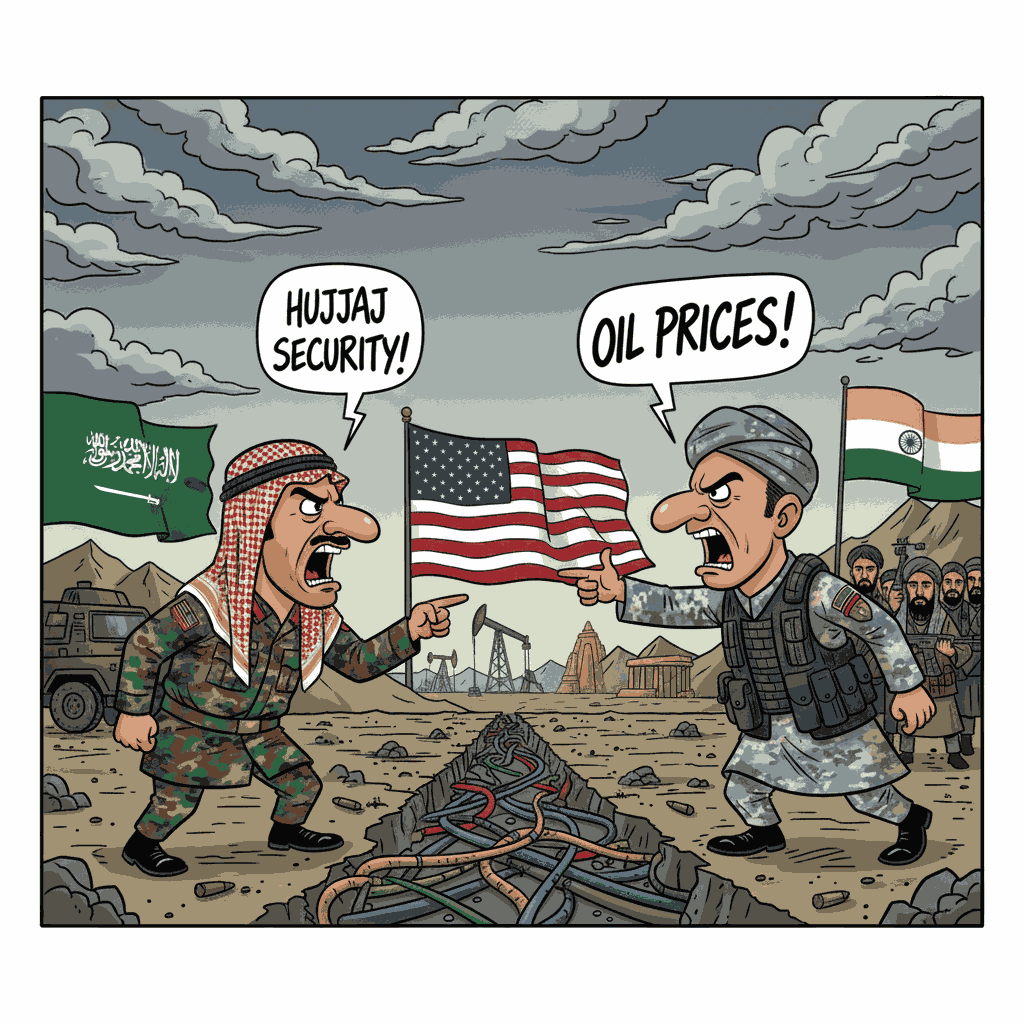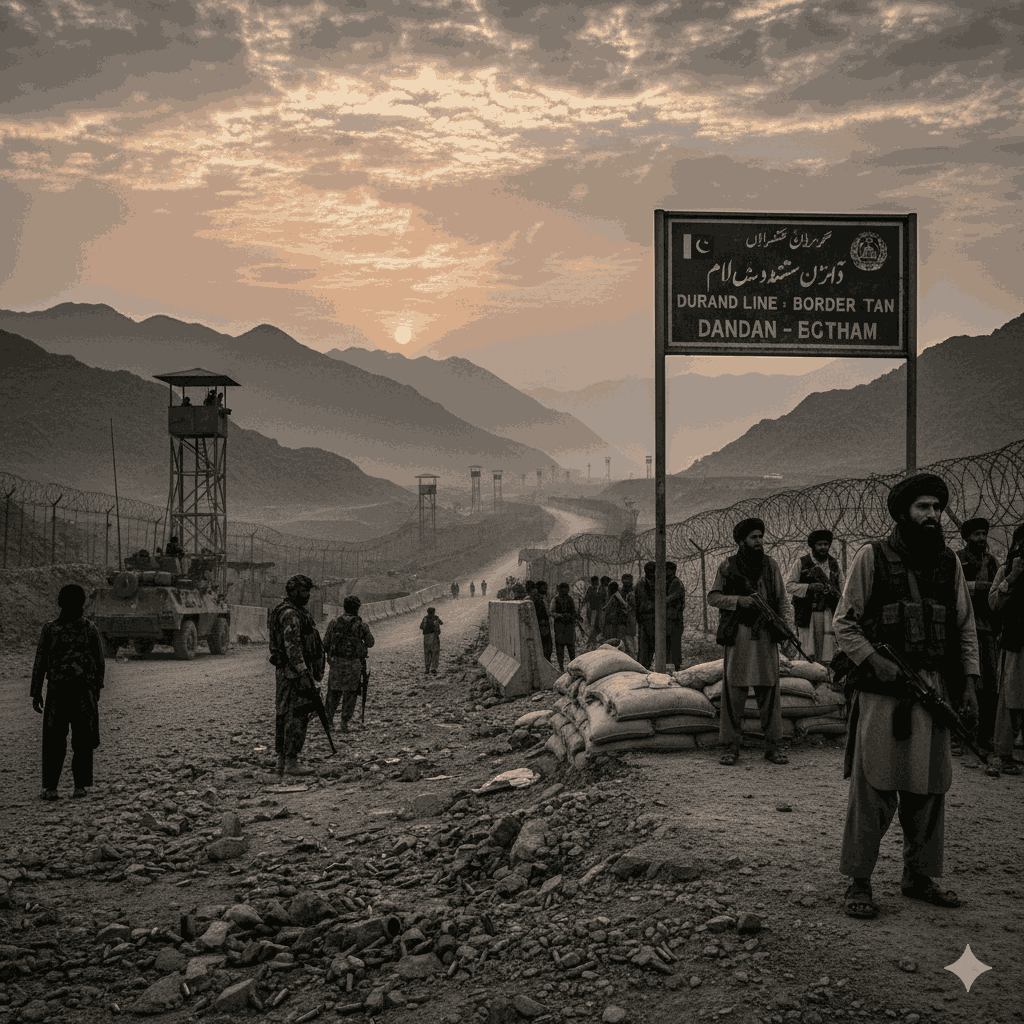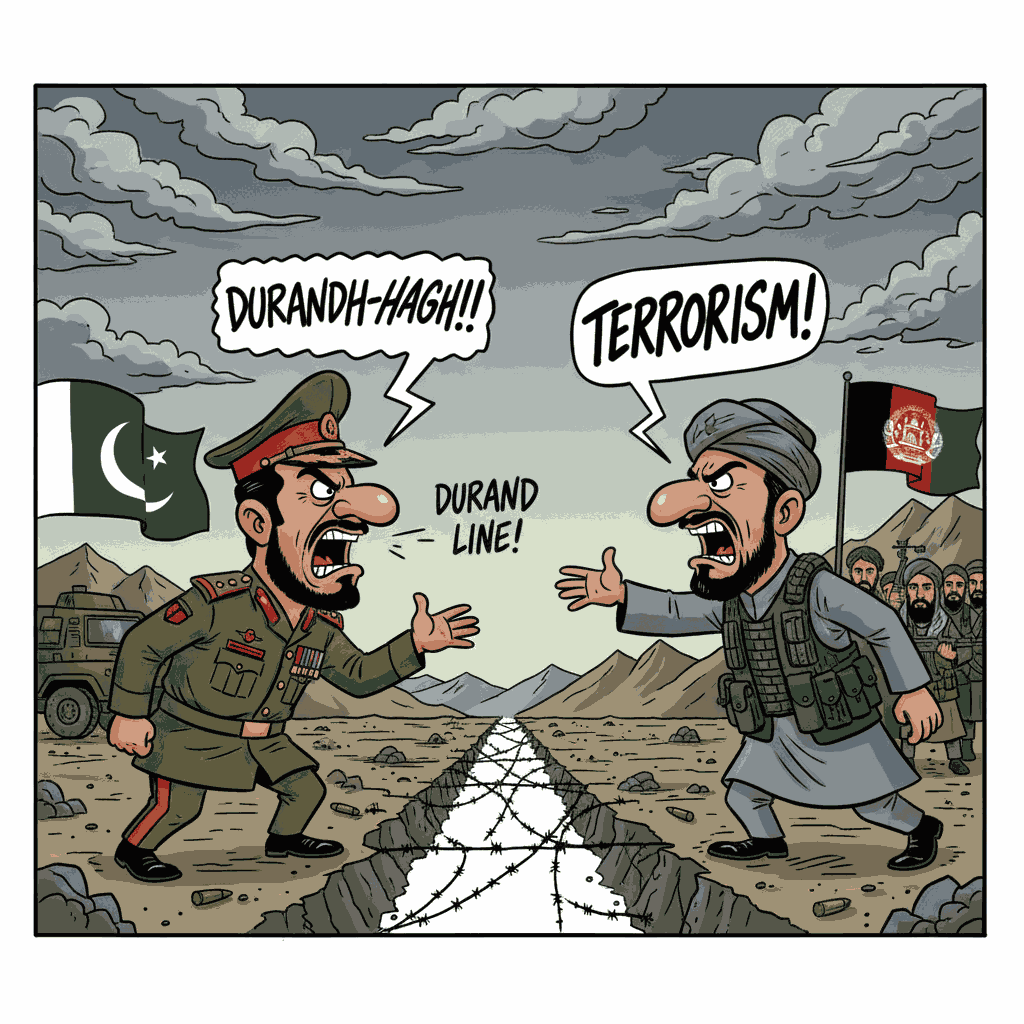A Deep Research Report on the Pakistan-Afghanistan Border Crisis and its Regional Implications
Table of Contents
- 1. The Enduring Durand Line Dispute: A Legacy of Colonialism and Conflict
- 2. Escalation to Open Warfare: The October 2025 Crisis
- 3. The Role of Militant Groups and Strategic Calculations
- 4. The Humanitarian Fallout and Socio-Economic Dimensions
- 5. Impact on the United States and Shifting Dynamics with India
- 6. De-escalation Efforts and the Path Forward
- Frequently Asked Questions (FAQs)
1. The Enduring Durand Line Dispute: A Legacy of Colonialism and Conflict
Historical Background of the Durand Line
The ongoing tension and occasional armed conflict between Pakistan and Afghanistan stem from a century-old dispute over their shared border, known as the Durand Line.
This 1,600-mile (2,600 km) frontier was established in 1893 to divide the spheres of influence between British India and the Emirate of Afghanistan.
The agreement was signed between Sir Henry Mortimer Durand, the Foreign Secretary of British India, and Emir Abdur Rahman Khan of Afghanistan.
It was never meant to be a permanent international boundary. Instead, it served as a buffer zone during the “Great Game,” meant to secure the Khyber Pass and the northern frontier of British India from Russian expansion.
One colonial official, Sir Denis Fitzpatrick, even stated that the intent was only to exclude Afghan interference west of the line, not to define lasting sovereignty.

Ethnic Division and the Afghan Perspective
The Durand Line cut through the homelands of the Pashtun and Baloch peoples, splitting families, villages, and farmlands between two countries.
From Afghanistan’s point of view, this was a historical injustice against its ethnic Pashtun population, who have long demanded self-determination and access to the sea.
This demand evolved into the nationalist movement for an independent ‘Pashtunistan’.
No Afghan government has ever officially recognized the Durand Line as a legitimate international border.
In 1949, after a Pakistani airstrike on alleged militant camps inside Afghanistan, a Loya Jirga (grand council) in Kabul rejected all previous boundary treaties with Britain and formally endorsed the idea of ‘Pashtunistan’.
This decision deepened diplomatic hostility and marked the start of decades of mistrust.
Pakistan’s Perspective: Sovereignty and Security
In contrast, Pakistan considers the Durand Line a legal and internationally recognized border.
It bases this claim on treaties signed between 1893 and 1930 and the legal principle of uti possidetis juris — meaning that new states inherit the administrative boundaries of their predecessors at independence .
When Pakistan was created in 1947, it inherited the border and has since viewed any challenge to it as a threat to its sovereignty .
This fear intensified after the 1971 secession of East Pakistan (now Bangladesh), which left a lasting trauma about territorial loss.
For Pakistan, the Durand Line is not just geography; it’s a core part of national security.
Indeed, the dispute soon turned violent:
- 1949–1950: First major clashes occurred after Pakistan bombed Afghan-backed militant camps [[9]].
- 1961: Relations were broken off after Pakistani airstrikes led to closure of the Torkham border crossing.
Although international bodies such as the UK government, SEATO, and the Organisation of Islamic Cooperation recognized Pakistan’s legal claim , Afghanistan continued to reject it.
Notably, Afghanistan was the only UN member to vote against Pakistan’s admission in 1947.
Even today, while Afghan mapping agencies show the Durand Line as an international boundary, this technical depiction does not match political or popular opinion, as Afghan leaders still denounce it as a colonial imposition .
2. Escalation to Open Warfare: The October 2025 Crisis
Immediate Triggers
In October 2025, the long-standing border dispute exploded into a major military confrontation.
This marked a serious escalation of hostilities that had been building for years.
The immediate cause was a series of coordinated strikes and counter-strikes along the border, each side accusing the other of violating airspace and initiating aggression.
On October 9–10, 2025, Pakistan carried out airstrikes in Kabul, Khost, Jalalabad, and Paktika.
Its military claimed that Noor Wali Mehsud, the leader of the Tehrik-i-Taliban Pakistan (TTP), was hiding near Abdul Haq Square in Kabul.
Mehsud survived and released a video vowing revenge, signaling TTP retaliation.
Afghanistan denied harboring TTP leaders and accused Pakistan of violating Afghan airspace, a claim backed by Afghan Foreign Minister Amir Khan Muttaqi, who called the attack a “provocative act”.
Retaliation and Escalation
In response, on October 11–12, 2025, Afghan Taliban forces launched what Pakistan called “massive strikes” across the border.
Afghan officials claimed 58 Pakistani soldiers were killed, while Pakistan reported 23 killed and 29 wounded .
During the fighting, Pakistan reportedly captured up to 19 Afghan border posts, further worsening the conflict.
The clashes coincided with Afghan Foreign Minister Muttaqi’s visit to India, suggesting deeper regional tensions.
Timeline of Major Clashes
| Date | Incident | Location/Details | Casualties/Figures |
|---|---|---|---|
| May 2017 | Violent clashes near Chaman border post. | Pakistan’s census in disputed “divided villages.” | 13 killed, 80 wounded (mostly Pakistani). |
| Dec 2019 | Cross-border fire incidents. | Resistance to Pakistani post construction. | Data not available. |
| Feb 2024 | Airstrikes in Kunar province. | After TTP killed seven Pakistani soldiers. | 50 militants, 1 Afghan soldier killed (Pak); 5 TTP members & family (locals). |
| Sept 2024 | Border post construction attempt near Kurram. | Triggered Pakistani fire. | 8 Taliban fighters killed, 5 Pakistani soldiers injured. |
| Dec 2024 | Airstrikes in Khost & Paktika. | After TTP attack in Pakistan. | 46 civilians killed (Afghan claim); 8 civilians (Taliban); 50 militants (Pak). |
| Oct 2025 | Coordinated airstrikes and retaliatory strikes. | Kabul, Khost, Paktika. | 58 killed (Afghan claim); 23 killed, 29 wounded (Pak). |
This pattern shows a recurring cycle — TTP attacks provoke Pakistani military action, which triggers Afghan retaliation.
The October 2025 crisis was the most intense example of this cycle.
3. The Role of Militant Groups and Strategic Calculations
The Central Role of the TTP
Understanding the border conflict requires looking at the influence of non-state actors, especially the Tehrik-i-Taliban Pakistan (TTP).
Founded in 2007 by Baitullah Mehsud, the TTP is an Islamist militant group opposed to the Pakistani state.
It operates mainly from eastern Afghanistan, using the area as a base for attacks across the Durand Line.
In 2024 alone, the TTP carried out 600 attacks, killing thousands.
Pakistan’s Countermeasures
Pakistan sees the TTP as an existential threat and regularly conducts air and ground operations inside Afghanistan to destroy its camps.
These strikes are presented as counter-terrorism actions, but they often cause civilian casualties, creating resentment in Afghanistan and fueling more violence.
Afghanistan’s Dilemma
The Afghan Taliban are caught in a bind:
- They sympathize ideologically with the TTP and refuse to take action against it.
- They argue that they cannot target one militant group (TTP) while allowing others like ISIS-Khorasan to operate.
- Yet, this refusal gives Pakistan a reason to intervene militarily, worsening relations .
This complex situation means the Taliban’s own security is at risk, attacked by both ISIS-K and Pakistan, while unable to control allied militant factions.
Regional Power Politics
Pakistan has long sought “strategic depth” in Afghanistan — a friendly government to counter India’s influence.
However, by supporting the Taliban, Pakistan created a rival power that now acts independently and harbors anti-Pakistan elements.
This blowback includes assassination attempts and internal instability.
Meanwhile, Pakistan blames Afghan refugees for domestic problems, further worsening ties.
The TTP, exploiting this mistrust, may now gain more freedom and support from the Afghan Taliban.
4. The Humanitarian Fallout and Socio-Economic Dimensions
Afghanistan’s Humanitarian Collapse
Both nations are facing severe humanitarian consequences.
In Afghanistan, 23.7 million people — more than half the population — need urgent aid.
This crisis worsened after the U.S. ended most aid in 2025, including food and education programs.
- Over 15,000 malnourished children lost treatment access.
- Around 14 million Afghans lack healthcare.
- The World Food Programme warned that cuts could be a “death sentence” for millions.
The Taliban’s restrictive policies, such as the 2024 “Law on the Promotion of Virtue and the Prevention of Vice,” have banned women from work and education, shutting down 400 health clinics and worsening suffering.

Pakistan’s Economic and Refugee Crisis
Pakistan faces its own troubles:
- Severe economic downturn, delayed civil service salaries, and currency depreciation.
- Between October 2023 and April 2025, it deported over one million Afghan refugees, including 60,000 in just two weeks .
- These deportations have triggered a refugee crisis inside Afghanistan, violating international human rights norms.
Pakistan also fears hydropolitical tension with India over the Shahtoot Dam on the Kabul River, which could affect its agriculture.
Thus, the crisis spans security, economy, and environment.
5. Impact on the United States and Shifting Dynamics with India
Changing U.S. Role
The U.S. decision to cut aid in 2025 weakened its influence in the region.
This move left the Taliban more dependent on China and Russia, while the U.S. became a marginal player.
Now, China, through the China-Pakistan Economic Corridor (CPEC), and countries like Qatar and Saudi Arabia, are stepping in as mediators.
India’s Strategic Opportunity
Amid this power vacuum, India has found a chance to expand its influence in Afghanistan.
The visit of Afghan Foreign Minister Amir Khan Muttaqi to New Delhi in late 2025 marked a turning point.
India pledged to build hospitals, trauma centers, and clinics, and to open direct trade routes via the Attari–Wagah border .
This outreach helps counter Pakistan’s influence while strengthening India-Afghanistan ties.
India’s deeper involvement also opens a new front in the India-Pakistan rivalry, potentially reshaping regional power dynamics.
6. De-escalation Efforts and the Path Forward
Attempts at Peace and Mediation
Despite the violence, there have been efforts to de-escalate.
In June 2017, China facilitated a crisis prevention mechanism between Pakistan and Afghanistan .
Similarly, talks in April 2025 between Pakistan’s Deputy PM Ishaq Dar and Taliban leaders, mediated by China, briefly reduced border violence .
However, the October 2025 clashes after Muttaqi’s India visit destroyed much of this fragile peace [[6,8]].
Future Prospects and Challenges
Analysts believe that resolving the Durand Line issue will require negotiation and compromise, not total victory for either side.
Possible solutions include:
- Territorial adjustments,
- Economic and infrastructure concessions, or
- A national Afghan debate on the border’s future .
Yet, any move toward recognition risks domestic backlash in Afghanistan, especially from Pashtun nationalists.
Conclusion
Lasting peace depends on addressing root causes:
- Pakistan must rethink its strategic depth policy, which created internal instability .
- Afghanistan must manage its internal factions and extremist elements.
- The international community must shift focus from short-term fixes to long-term structural reforms — governance, economy, and disarmament.
Without such coordinated efforts, the cycle of violence along the Durand Line will continue, endangering the entire South Asian region.
Here are 25 highly searchable FAQs on the current Pakistan-Afghanistan crisis, each with concise answers. These can help people understand the key issues, actors, and implications.
Frequently Asked Questions (FAQs)
- What is the main cause of the current Pakistan-Afghanistan border crisis?
The crisis stems from escalating tensions over the disputed Durand Line border, cross-border militant attacks (especially by the Tehrik-i-Taliban Pakistan, TTP), and mutual accusations of violating sovereignty. (Reuters) - What is the Durand Line, and why is it controversial?
The Durand Line is a colonial-era boundary established in 1893 between British India and Afghanistan. Afghanistan has historically not recognized it as a legal international border, while Pakistan considers it binding. It divides Pashtun and Baloch communities across both sides. (GKToday) - Who is the Tehrik-i-Taliban Pakistan (TTP), and what role do they play in this conflict?
The TTP is a militant group opposed to Pakistan’s government, known for launching attacks in Pakistan. Pakistan accuses Afghanistan of providing them safe haven or support, leading to increased cross-border military operations. (GKToday) - What recent events triggered the latest escalation (October 2025)?
On October 9-10, 2025, Pakistan carried out airstrikes targeting TTP leaders in Afghan provinces, including Kabul, Khost, and Paktika. Afghanistan responded with retaliatory strikes across the Durand Line, leading to clashes, border post takeovers, and casualties on both sides. (Reuters) - How many casualties have there been in the recent border clashes?
The numbers are disputed: Afghanistan claims it killed 58 Pakistani soldiers, while Pakistan reported 23 killed and 29 wounded. There are also claims of Pakistani capture of Afghan border posts. (Politico) - Which border crossings have been affected, and why?
Major crossings like Torkham and Chaman, as well as smaller ones like Kharlachi and Ghulam Khan, have been closed following exchange of fire and clashes. Closures affect trade and civilian movement. (Reuters) - What is Pakistan’s stated objective in its cross-border operations?
Pakistan says its operations target militant camps of the TTP in Afghan territory in order to prevent attacks against Pakistani soil and protect its sovereignty. (GKToday) - How does Afghanistan (Taliban government) respond to Pakistan’s accusations?
Afghanistan denies harboring militants that attack Pakistan, frames Pakistani airstrikes as violations of its sovereignty, and asserts its right to defend its territory. (Reuters) - What have been the humanitarian impacts of the crisis?
Border closures have disrupted trade, causing economic losses. Civilians have been displaced. The humanitarian situation in Afghanistan is already fragile, with many people lacking health care, food, and basic services. (Reuters) - Are there any diplomatic efforts underway to de-escalate tensions?
Yes — mediation by regional actors like China, Qatar, and Saudi Arabia is underway. There have been high-level meetings and attempts at ceasefire agreements. (Reuters) - What role does India play in the Pakistan-Afghanistan crisis?
India has strengthened diplomatic ties with the Taliban government. Afghanistan’s Foreign Minister visited New Delhi in late 2025. Pakistan views this as a shift in regional alliances and possible support to Afghanistan against Pakistan. (GKToday) - How do border fencing and construction of outposts contribute to the crisis?
Border fencing by Pakistan is seen by Afghanistan as provocative, dividing communities. Construction of border posts has triggered confrontations, especially around Torkham. (Dawn) - How many Afghan refugees are affected or have been deported from Pakistan?
Over one million Afghan nationals have been deported from Pakistan between October 2023 and April 2025. Tens of thousands in shorter time spans have also been deported. (GKToday) - What are the economic consequences for both countries?
Trade disruptions due to border closures, stranded goods and trucks, loss of livelihoods, increased costs. Pakistan faces inflation and domestic strain; Afghanistan’s import trade is heavily affected. (Reuters) - How does this crisis affect regional stability?
The conflict raises the risk of wider escalation among neighbouring countries, might invite external involvement, increases cross-border militancy, and destabilizes trade and humanitarian pathways. (Politico) - Is there any international law or treaty governing border claims like Durand Line?
The principle of uti possidetis juris is often cited (new states inherit colonial administrative boundaries). But Afghanistan disputes recognition of the Durand Line, saying colonial imposition is illegitimate. (GKToday) - Why does Pakistan insist on treating the Durand Line as the official border?
Because it inherited the border at the time of partition in 1947, treats it as essential to national sovereignty, and wants secure frontiers against jihadi groups using Afghan territory. (GKToday) - What are Afghanistan’s concerns about Pashtun rights and identity in this dispute?
The Pashtun population lives on both sides of the Durand Line; many feel divided by the border. Afghanistan views the Durand Line as a colonial artifact that splits ethnic communities. (Dawn) - How credible are claims about casualty figures from both sides?
They are contested. Each side reports different numbers; independent verification is difficult due to limited access and conflicting narratives. (Politico) - What are the risks of this border crisis turning into a full-scale war?
High tensions, repeated airstrikes, capture of military posts, increasing militarisation, and broken trust all heighten risk. But diplomatic channels and mediators are working to prevent full escalation. (Reuters) - How is the media framing this conflict domestically on both sides?
Pakistani media often emphasizes sovereignty, security, and threat from militants. Afghan media highlights violations of sovereignty, civilian harm, and calls for international attention. Propaganda and narrative framing are prominent. (IAS EXPRESS) - What has been the response of international organizations (UN, neighbours)?
The United Nations, neighbouring countries, and regional blocs have called for restraint and reopening of crossings. Some nations offer mediation. Aid agencies warn of worsening humanitarian crisis. (Reuters) - How do internal politics in Pakistan and Afghanistan influence the crisis?
In Pakistan, political pressure to curb militant attacks; in Afghanistan, challenges balancing TTP relations, internal hardliners, and maintaining international legitimacy. Political narratives are strongly tied to border sovereignty and security. (GKToday) - What are possible scenarios for resolution or de-escalation?
Negotiated agreements on border demarcation or tacit recognition of the Durand Line; stronger border control by Afghanistan; economic concessions; third-party mediation; confidence-building measures. (GKToday) - What should people outside the region monitor to understand how this crisis evolves?
Key indicators include: closure/reopening of border crossings; changes in casualty reports; movement of TTP leaders; diplomatic outreach (visits, bilateral talks); international responses or pressures; internal stability of both governments.

